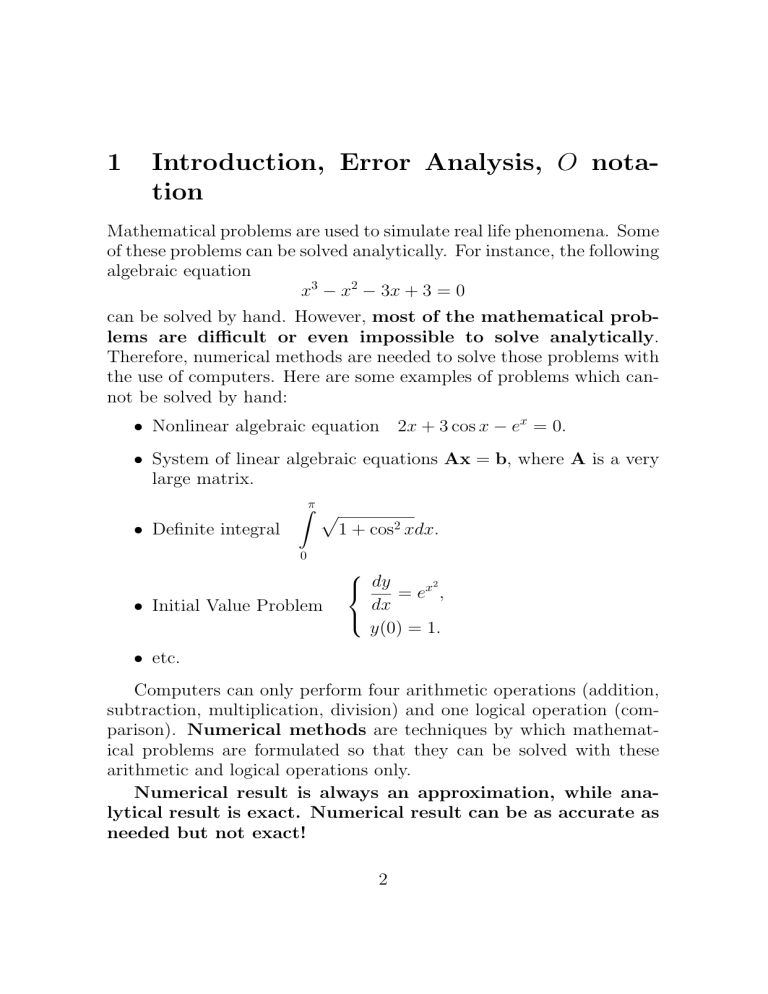
1
Introduction, Error Analysis, O notation
Mathematical problems are used to simulate real life phenomena. Some
of these problems can be solved analytically. For instance, the following
algebraic equation
x3 − x2 − 3x + 3 = 0
can be solved by hand. However, most of the mathematical problems are difficult or even impossible to solve analytically.
Therefore, numerical methods are needed to solve those problems with
the use of computers. Here are some examples of problems which cannot be solved by hand:
• Nonlinear algebraic equation 2x + 3 cos x − ex = 0.
• System of linear algebraic equations Ax = b, where A is a very
large matrix.
Zπ p
• Definite integral
1 + cos2 xdx.
0
• Initial Value Problem
dy = ex2 ,
dx
y(0) = 1.
• etc.
Computers can only perform four arithmetic operations (addition,
subtraction, multiplication, division) and one logical operation (comparison). Numerical methods are techniques by which mathematical problems are formulated so that they can be solved with these
arithmetic and logical operations only.
Numerical result is always an approximation, while analytical result is exact. Numerical result can be as accurate as
needed but not exact!
2
Lecture Notes - Numerical Methods
1.1
M.Ashyraliyev
Absolute and Relative Errors
Definition 1.1. Suppose x̂ is an approximation to x. The absolute
error Ex in the approximation of x is defined as the magnitude of the
difference between exact value x and the approximated value x̂. So,
Ex = |x − x̂|.
(1.1)
The relative error Rx in the approximation of x is defined as the
ratio of the absolute error to the magnitude of x itself. So,
Rx =
|x − x̂|
,
|x|
x 6= 0.
(1.2)
Example 1.1. Let x̂ = 1.02 be an approximation of x = 1.01594,
ŷ = 999996 be an approximation of y = 1000000 and ẑ = 0.000009 be
an approximation of z = 0.000012. Then
Ex = |x − x̂| = |1.01594 − 1.02| = 0.00406,
Rx =
|x − x̂| |1.01594 − 1.02|
=
= 0.0039963,
|x|
|1.01594|
Ey = |y − ŷ| = |1000000 − 999996| = 4,
Ry =
|y − ŷ| |1000000 − 999996|
=
= 0.000004,
|y|
|1000000|
Ez = |z − ẑ| = |0.000012 − 0.000009| = 0.000003,
Rz =
|z − ẑ| |0.000012 − 0.000009|
=
= 0.25.
|z|
|0.000012|
Note that Ex ≈ Rx , Ry << Ey and Ez << Rz .
3
Lecture Notes - Numerical Methods
1.2
M.Ashyraliyev
Types of Errors in Numerical Procedures
When applying a numerical method to solve a certain mathematical
problem on the computer, one has to be aware of two main types of
errors which may affect significantly the numerical result. The first
type of errors, so called truncation errors, occur when a mathematical problem is reformulated so that it can be solved with arithmetic
operations only. The other type of errors, so called round-off errors,
occur when a machine actually does those arithmetic operations.
Here are some real life examples of what can happen when errors
in numerical algorithms are underestimated.
• The Patriot Missile failure, in Dharan, Saudi Arabia, on February
25, 1991 which resulted in 28 deaths, is ultimately attributable
to poor handling of rounding errors.
• The explosion of the Ariane 5 rocket just after lift-off on its
maiden voyage off French Guiana, on June 4, 1996, was ultimately the consequence of a simple overflow.
• The sinking of the Sleipner A offshore platform in Gandsfjorden
near Sta-vanger, Norway, on August 23, 1991, resulted in a loss
of nearly one billion dollars. It was found to be the result of
inaccurate finite element analysis.
1.2.1
Truncation Errors
Four arithmetic operations are sufficient to evaluate any polynomial
function. But how can we evaluate other functions by using only four
arithmetic operations?
For instance, how do we find the value of func√
tion f (x) = x at x = 5?
With the help of classical Taylor’s theorem, functions can be approximated with polynomials. Let us first recall the Taylor’s theorem
known from Calculus.
4
Lecture Notes - Numerical Methods
M.Ashyraliyev
Theorem 1.1. (Taylor’s Theorem)
Suppose function f has continuous n + 1 derivatives on interval [a, b].
Then for any points x and x0 from [a, b], there exists a number ξ
between x and x0 such that
f (x) = Pn (x) + Rn (x),
(1.3)
where
f 00 (x0 )
f (n) (x0 )
2
Pn (x) = f (x0 )+f (x0 )(x−x0 )+
(x−x0 ) +. . .+
(x−x0 )n
2!
n!
(1.4)
is called the n-th degree Taylor polynomial and
0
f (n+1) (ξ)
Rn (x) =
(x − x0 )n+1
(n + 1)!
(1.5)
is called the remainder term. (1.3)-(1.5) is called Taylor expansion
of function f (x) about point x0 .
Remark 1.1. If the remainder term Rn (x) in (1.3) is small enough then
function f (x) can be approximated with Taylor polynomial Pn (x). So
that
f (x) ≈ Pn (x).
(1.6)
Then, the error in this approximation is the magnitude of the remainder term Rn (x), since E = |f (x) − Pn (x)| = |Rn (x)|. In numerical
analysis, remainder term (1.5) is usually called a truncation error of
approximation (1.6).
Example 1.2. Let f (x) = ex . Then, using Taylor’s theorem with
x0 = 0, we have
ex = Pn (x) + Rn (x),
where
x x2 x3
xn
Pn (x) = 1 + +
+
+ ... +
1! 2!
3!
n!
5
Lecture Notes - Numerical Methods
M.Ashyraliyev
is a Taylor polynomial and
xn+1
Rn (x) = e
(n + 1)!
ξ
is a remainder term (or truncation error) associated with Pn (x). Here
ξ is some point between 0 and x.
Now, assume that we want to approximate the value of f (1) = e with
Taylor polynomials. The exact value of number e is known from the
literature; it is e = 2.718281828459 . . .
Taylor polynomials up to degree 5 for function f (x) = ex are:
P0 (x) = 1,
P1 (x) = 1 + x,
x2
,
2
x2
P3 (x) = 1 + x +
+
2
x2
P4 (x) = 1 + x +
+
2
x2
P5 (x) = 1 + x +
+
2
P2 (x) = 1 + x +
x3
,
6
x3
+
6
x3
+
6
x4
,
24
x4
x5
+
.
24 120
Then
P0 (1) = 1
=⇒ Error = |f (1) − P0 (1)| = 1.718281828459 . . .
P1 (1) = 2
=⇒ Error = |f (1) − P1 (1)| = 0.718281828459 . . .
P2 (1) = 2.5
=⇒ Error = |f (1) − P2 (1)| = 0.218281828459 . . .
P3 (1) = 2.666666 . . . =⇒ Error = |f (1) − P3 (1)| = 0.051615161792 . . .
P4 (1) = 2.708333 . . . =⇒ Error = |f (1) − P4 (1)| = 0.009948495126 . . .
P5 (1) = 2.716666 . . . =⇒ Error = |f (1) − P5 (1)| = 0.001615161792 . . .
We observe that truncation error decreases as we use higher degree
Taylor polynomials.
6
Lecture Notes - Numerical Methods
M.Ashyraliyev
Now, let us find the degree of Taylor polynomial that should be used
to approximate f (1) so that the error is less than 10−6 . We have
Rn (1) =
e
3
eξ
≤
<
< 10−6
(n + 1)!
(n + 1)! (n + 1)!
=⇒
n ≥ 9.
So, analyzing the remainder term we can say that 9-th degree Taylor
polynomial is certain to give an approximation with error less than
10−6 . Indeed, we have
1 1 1 1 1 1 1 1 1
+ + + + + + + + = 2.718281525573 . . .
1! 2! 3! 4! 5! 6! 7! 8! 9!
for which |f (1) − P9 (1)| = 0.000000302886 . . . < 10−6 .
P9 (1) = 1+
Example 1.3. Consider the definite integral
Z1/2
2
p = ex dx = 0.544987104184 . . .
0
From previous example we have approximation
x x2 x3 x4
e ≈1+ +
+
+
1! 2!
3!
4!
Replacing x with x2 , we get
x
x2
e
x2 x4 x6 x8
≈1+
+
+
+
1!
2!
3!
4!
Then
Z1/2
Z1/2
4
6
8
x
x
x
2
p = ex dx ≈
1 + x2 +
+
+
dx =
2
6
24
0
0
x3 x5 x7
x9
= x+
+
+
+
3
10 42 216
=
1/2
=
0
1
1
1
1
1
+
+
+
+
= 0.54498672 . . . = p̂
2 3 · 23 10 · 25 42 · 27 216 · 29
7
Lecture Notes - Numerical Methods
M.Ashyraliyev
with the error in approximation being |p − p̂| ≈ 3.8 × 10−7 .
Example 1.4. What is the maximum possible error in using the approximation
x3 x5
+
sin x ≈ x −
3!
5!
when −0.3 ≤ x ≤ 0.3?
Solution: Using Taylor’s theorem for function f (x) = sin x with
x0 = 0, we have
x3 x5
+
+ R6 (x),
sin x = x −
3!
5!
where
f (7) (ξ) 7
x7
R6 (x) =
x = − cos (ξ)
7!
7!
Then for −0.3 ≤ x ≤ 0.3 we have
0.37
|x|7
≤
≈ 4.34 × 10−8 .
|R6 (x)| ≤
7!
7!
Remark 1.2. Truncation error is under control of the user. Truncation
error can be reduced as much as it is needed. However, it cannot be
eliminated entirely!
1.2.2
Round-off Errors
Computers use only a fixed number of digits to represent a number.
As a result the numerical values stored in a computer are said to have
a finite precision. Because of this round-off errors occur when the
arithmetic operations, performed in a machine, involve numbers with
only a finite number of digits.
Remark 1.3. Round-off errors depend on hardware and the computer
language used.
8
Lecture Notes - Numerical Methods
M.Ashyraliyev
To understand the effect of round-off errors we should first understand how numbers are stored on a machine. Although computers use
binary number system (so that every digit is 0 or 1), for simplicity of
explanation we will use here the decimal number system.
Any real number y can be normalized to achieve the form:
y = ±0.d1 d2 . . . dk−1 dk dk+1 dk+2 . . . × 10n
(1.7)
where n ∈ Z, 1 ≤ d1 ≤ 9 and 0 ≤ dj ≤ 9 for j > 1. For instance,
38
1
y=
= 0.126666 . . . × 102 or y =
= 0.3030303030 . . . × 10−1 .
3
33
Real number y in (1.7) may have infinitely many digits. As we
have already mentioned, computer stores only finite number of digits.
That’s why number y should be represented with so-called floatingpoint form of y, denoted by f l(y), which has let say only k digits.
There are two ways to perform this. One method, called chopping, is
to simply chop off in (1.7) the digits dk+1 dk+2 . . . to obtain
f lc (y) = ±0.d1 d2 . . . dk−1 dk × 10n
The other method, called rounding, is performed in the following way:
if dk+1 < 5 then the result is the same as chopping; if dk+1 ≥ 5 then
1 is added to k-th digit and the resulting number is chopped. The
floating-point form of y obtained with rounding is denoted by f lr (y).
Example 1.5. Determine five-digit (a) chopping and (b) rounding
22
values of numbers
= 3.14285714 . . . and π = 3.14159265 . . .
7
Solution:
1
(a) Five-digit chopping of numbers gives f lc 22
7 = 0.31428 × 10 and
f lc (π) = 0.31415 × 101 . Therefore, the errors of chopping are
22
22
−
≈ 5.7 × 10−5 ; |f lc (π) − π| ≈ 9.3 × 10−5 .
f lc
7
7
9
Lecture Notes - Numerical Methods
M.Ashyraliyev
1
(b) Five-digit rounding of numbers gives f lr 22
7 = 0.31429 × 10 and
f lr (π) = 0.31416 × 101 . So, the errors of rounding are
22
22
f lr
≈ 4.3 × 10−5 ; |f lr (π) − π| ≈ 7.3 × 10−6 .
−
7
7
We observe that the values obtained from rounding method have less
errors than the values obtained from chopping method.
Remark 1.4. The error that results from replacing a number with
its floating-point form is called round-off error regardless of whether
the rounding or chopping method is used. However, rounding method
results in less error than chopping method and that’s why it is preferred
generally.
1.2.3
Loss of Significance
A loss of significance can occur if two nearly equal quantities are
subtracted from one another. For example, both numbers a = 0.177241
and b = 0.177589 have 6 significant digits. But the difference of them
b − a = 0.000348 = 0.348 × 10−3 has only three significant digits. So,
in subtraction of these numbers three significant digits have been lost!
This loss is called subtractive cancellation.
Errors can also occur when two quantities of radically different
magnitudes are added. For example, if we add numbers x = 0.1234
and y = 0.6789 × 10−20 the result for x + y will be rounded to 0.1234
by a machine that keeps only 16 significant digits.
The loss of accuracy due to round-off errors can often be avoided by
a careful sequencing of operations or a reformulation of the problem.
We will describe this issue with examples.
√
√ Example 1.6. Consider two functions f (x) = x
x + 1 − x and
x
g(x) = √
√ . Evaluate f (500) and g(500) using six-digits
x+1+ x
10
Lecture Notes - Numerical Methods
M.Ashyraliyev
arithmetic with rounding method and compare the results in terms of
errors.
Solution: Using six-digits arithmetic with rounding method, we have
√
√ ˆ
f (500) = 500 ·
501 − 500 = 500 · (22.3830 − 22.3607) =
= 500 · 0.0223 = 11.1500
and
500
500
500
√
=
=
= 11.1748.
501 + 500 22.3830 + 22.3607 44.7437
Note that the exact values of these two functions at x = 500 are the
same, namely f (500) = g(500) = 11.1747553 . . . Then, the absolute errors in approximations of f (500) and g(500), when six-digits arithmetic
with rounding method is used, are as following:
ĝ(500) = √
Ef = |f (500) − fˆ(500)| ≈ 2.5 × 10−2 ,
Eg = |g(500) − ĝ(500)| ≈ 4.5 × 10−5 .
Although f (x) ≡ g(x), we see that using g(x) function results in much
less error than using f (x) function. It is only due to the loss of significance which occurred in f (x) when we subtracted nearly equal numbers. By rewriting function f (x) in the form of g(x) we eliminated
that subtractive cancellation.
3
2
Example 1.7.
Consider two
polynomials P (x) = x − 3x + 3x − 1
and Q(x) = (x − 3)x + 3 x − 1. Evaluate P (2.19) and Q(2.19) using
three-digits arithmetic with rounding method and compare the results
in terms of errors.
Solution: Using three-digits arithmetic with rounding method, we
have
P̂ (2.19) = 2.193 − 3 · 2.192 + 3 · 2.19 − 1 =
= 2.19 · 4.80 − 3 · 4.80 + 6.57 − 1 = 10.5 − 14.4 + 5.57 =
= −3.9 + 5.57 = 1.67
11
Lecture Notes - Numerical Methods
M.Ashyraliyev
and
Q̂(2.19) =
(2.19 − 3) · 2.19 + 3 · 2.19 − 1 =
= (−0.81 · 2.19 + 3) · 2.19 − 1 = (−1.77 + 3) · 2.19 − 1 =
= 1.23 · 2.19 − 1 = 2.69 − 1 = 1.69.
Note that the polynomials P (x) and Q(x) are the same and
P (2.19) = Q(2.19) = 1.685159. Then, the absolute errors in approximations of P (2.19) and Q(2.19), when three-digits arithmetic with
rounding method is used, are as following:
EP = |P (2.19) − P̂ (2.19)| = 0.015159,
EQ = |Q(2.19) − Q̂(2.19)| = 0.004841.
Although P (x) ≡ Q(x), we see that using polynomial Q(x) results in
three times less error than using polynomial P (x). Moreover, if we
count the number of arithmetic operations, we observe that evaluation
of polynomial Q(x) needs less number of arithmetic operations than
evaluation of polynomial P (x). Indeed,
• it requires 4 multiplications and 3 additions/subtractions to evaluate the polynomial P (x);
• it requires 2 multiplications and 3 additions/subtractions to evaluate the polynomial Q(x).
Remark 1.5. The polynomial Q(x) in Example 1.7 is called a nested
structure of polynomial P (x). Evaluation of nested structure of polynomial requires less arithmetic operations and often has less error.
1.2.4
Propagation of Error
When repeating arithmetic operations are performed on the computer,
round-off errors sometimes have tendency to accumulate and therefore
12
Lecture Notes - Numerical Methods
M.Ashyraliyev
to grow up. Let us illustrate this issue on the base of two arithmetic
operations, addition and multiplication of two numbers.
Let p̂ be an approximation of number p and q̂ be an approximation
of number q. Then
p = p̂ + p
and q = q̂ + q
where p and q are the errors in the approximations p̂ and q̂, respectively. Assume that both p and q are positive. Then
p + q = p̂ + q̂ + (p + q ).
Therefore, approximation of p+q with p̂+ q̂ has an error p +q . So, the
absolute error in the sum p + q can be as large as the sum of absolute
errors in p and q.
Assuming that p ≈ p̂ and q ≈ q̂, we have
Rpq =
p̂q + q̂p + p q
q p
pq − p̂q̂
=
≈ + = Rq + Rp .
pq
pq
q
p
So, the relative error in the product pq can be approximately as large
as the sum of relative errors in p and q.
1.3
O notation
∞
Definition 1.2. Suppose {pn }∞
n=1 and {qn }n=1 are sequences of real
numbers. If there exist positive constant C and natural number N
such that
|pn | ≤ C|qn | for all n ≥ N,
then we say that {pn } is of order {qn } as n → ∞ and we write
pn = O(qn ).
Example 1.8. Let {pn }∞
n=1 be a sequence of numbers defined by
2
pn = n + n for all n ∈ N.
Since for all n ≥ 1 we have pn = n2 + n ≤ n2 + n2 = 2n2 , it follows
that pn = O(n2 ).
13
Lecture Notes - Numerical Methods
M.Ashyraliyev
Example 1.9. Let {pn }∞
n=1 be a sequence of numbers defined by
n+1
for all n ∈ N.
pn =
n2
n+1
n+n
2
Since for all n ≥ 1 we have pn =
≤
=
, it follows that
n2
n2
n
1
pn = O
.
n
Example 1.10. Let {pn }∞
n=1 be a sequence of numbers defined by
n+3
pn =
for all n ∈ N.
2n3
n+3
n+n
1
Since for all n ≥ 3 we have pn =
≤
=
, it follows that
2n3
2n3
n2
1
pn = O
.
n2
Definition 1.3. Let f (x) and g(x) be two functions defined in some
open interval containing point a. If there exist positive constants C
and δ such that
|f (x)| ≤ C|g(x)| for all x with |x − a| < δ,
then we say that f (x) is of order g(x) as x → a and we write
f (x) = O(g(x)).
Example 1.11. Using Taylor’s theorem for function f (x) = ln (1 + x)
with x0 = 0, we have
x3
x2
+
,
ln (1 + x) = x −
2
3(1 + ξ)3
where ξ is some point between 0 and x. Since
constant, we have
ln (1 + x) = x −
1
3(1+ξ)3
is bounded by a
x2
+ O(x3 ) for x close to 0.
2
14
Lecture Notes - Numerical Methods
1.4
M.Ashyraliyev
Self-study Problems
Problem 1.1. Compute the absolute error and the relative error in
approximations of p by p̂
a) p = 3.1415927, p̂ = 3.1416
√
b) p = 2, p̂ = 1.414
c) p = 8!, p̂ = 39900
Problem 1.2. Find the fourth degree Taylor polynomial for the function f (x) = cos x about x0 = 0.
Problem 1.3. Find the third degree Taylor polynomial for the function f (x) = x3 − 21x2 + 17 about x0 = 1.
Problem 1.4. Let f (x) = ln (1 + 2x).
a) Find the fifth degree Taylor polynomial P5 (x) for given function
f (x) about x0 = 0
b) Use P5 (x) to approximate ln (1.2)
c) Determine the actual error of the approximation in (b)
Problem 1.5. Let f (x) =
√
x + 4.
a) Find the third degree Taylor polynomial P3 (x) for given function
f (x) about x0 = 0
√
√
b) Use P3 (x) to approximate 3.9 and 4.2
c) Determine the actual error of the approximations in (b)
15
Lecture Notes - Numerical Methods
M.Ashyraliyev
Problem 1.6. Determine the degree of Taylor polynomial Pn (x) for
the function f (x) = ex about x0 = 0 that should be used to approximate e0.1 so that the error is less than 10−6 .
Problem 1.7. Determine the degree of Taylor polynomial Pn (x) for
the function f (x) = cos x about x0 = 0 that should be used to approximate cos (0.2) so that the error is less than 10−5 .
Problem 1.8. Let f (x) = ex .
a) Find the Taylor polynomial P8 (x) of degree 8 for given function
f (x) about x0 = 0
b) Find an upper bound for error |f (x) − P8 (x)| when −1 ≤ x ≤ 1
c) Find upper bound for error |f (x) − P8 (x)| when −0.5 ≤ x ≤ 0.5
Problem 1.9. Let f (x) = ex cos x.
a) Find the second degree Taylor polynomial P2 (x) for given function f (x) about x0 = 0
b) Use P2 (0.5) to approximate f (0.5)
c) Find an upper bound for error |f (0.5) − P2 (0.5)| and compare it
to the actual error
Z1
d) Use
Z1
P2 (x)dx to approximate
0
f (x)dx.
0
e) Determine the actual error of the approximation in (d)
Problem 1.10. Use three-digit rounding arithmetic to perform the
following calculations. Find the absolute error and the relative error
in obtained results.
16
Lecture Notes - Numerical Methods
M.Ashyraliyev
a) (121 − 0.327) − 119
b) (121 − 119) − 0.327
c) −10π + 6e −
3
62
Problem 1.11. Let P (x) = x3 − 6.1x2 + 3.2x + 1.5
a) Use three-digit arithmetic with chopping method to evaluate
P (x) at x = 4.17 and find the relative error in obtained result
b) Rewrite P (x) in a nested structure. Use three-digit arithmetic
with chopping method to evaluate a nested structure at x = 4.17
and find the relative error in obtained result
Problem 1.12. Let P (x) = x3 − 6.1x2 + 3.2x + 1.5
a) Use three-digit arithmetic with rounding method to evaluate
P (x) at x = 4.17 and find the relative error in obtained result
b) Rewrite P (x) in a nested structure. Use three-digit arithmetic
with rounding method to evaluate a nested structure at x = 4.17
and find the relative error in obtained result
Problem 1.13. Consider two functions f (x) = x + 1 −
x
√
and g(x) =
.
x + 1 + x2 + x + 1
p
x2 + x + 1
a) Use four-digit arithmetic with rounding method to approximate
f (0.1) and find the relative error in obtained result.
(Note that the true value is f (0.1) = 0.0464346247 . . .)
b) Use four-digit arithmetic with rounding method to approximate
g(0.1) and find the relative error in obtained result.
(Note that the true value is g(0.1) = 0.0464346247 . . .)
17
Lecture Notes - Numerical Methods
M.Ashyraliyev
ex − e−x
Problem 1.14. Let f (x) =
.
x
a) Evaluate f (0.1) using four-digit arithmetic with rounding method
and find the relative error of obtained value.
(Note that the true value is f (0.1) = 2.0033350004 . . .)
b) Find the third degree Taylor polynomial P3 (x) for given function
f (x) about x0 = 0.
x2 x3 x4
x
+
+
+ . . .)
(You can use the formula e = 1 + x +
2!
3!
4!
c) For approximation of f (0.1) evaluate P3 (0.1) using four-digit
arithmetic with rounding method and find the relative error of
obtained value.
√
Problem 1.15. For which values of x the expression 2x2 + 1 − 1
would cause the loss of accuracy and how would you avoid the loss of
accuracy?
Problem 1.16. For which values of x and y the expression
ln (x) − ln (y) would cause the loss of accuracy and how would you
avoid the loss of accuracy?
Problem 1.17. For each of the following
sequences, find the largest
1
possible value of α such that pn = O
nα
1
1
1
a) pn = √
b) pn = sin
c) pn = ln 1 +
n
n
n2 + n + 1
Problem 1.18. For each of the following functions, find the largest
possible value of α such that f (x) = O (xα ) as x → 0.
a) f (x) = sin x−x
b) f (x) =
1 − cos x
x
18
c) f (x) =
ex − e−x
x
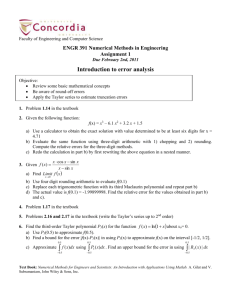
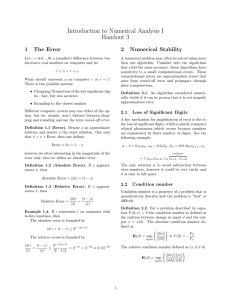
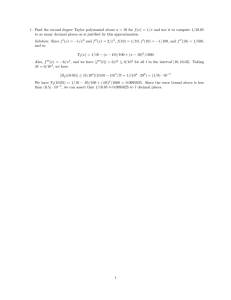
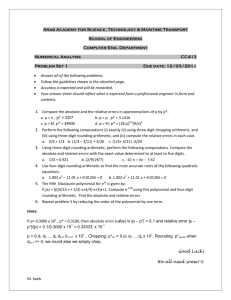
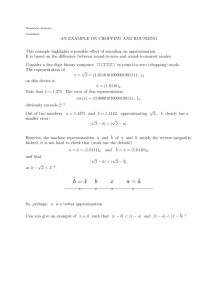
![Student number Name [SURNAME(S), Givenname(s)] MATH 100, Section 110 (CSP)](http://s2.studylib.net/store/data/011223986_1-37c276ae41f28d5dba87bc6d27e2a5b3-300x300.png)